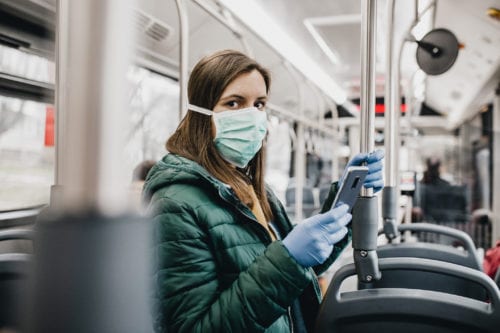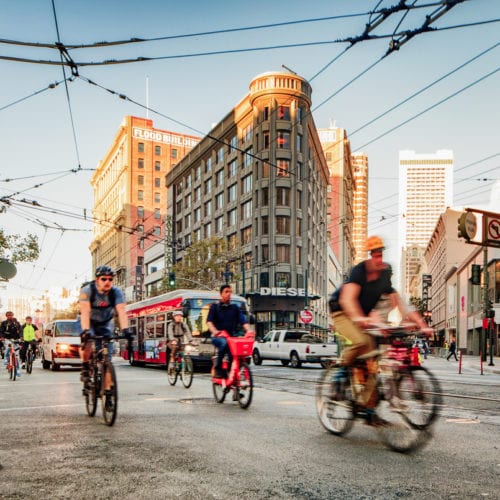Young woman is driving in a bus and wearing a protection mask from virus and holding smart phone

Getting Back on the Bus and Back to Work
The current pandemic has had an immediate and profound impact on public transit. Revenue is in free fall and ridership is at an all-time low. How will buses, trains, cars, and bikes play in our calculus as we return to work? Traffic data suggests an uptick in automobile traffic (even before states lifted shelter in place guidelines), raising the question of whether public transit riders will return. The long-term implications are not yet fully understood, but a return to cars is a well-trodden path—an inevitable increase in congestion and pollution, and the increased health risks that come with bad air quality.
While many are predicting the death of transit, this highly efficient mode is strategic to both lowering emissions per person trip and moving people effectively throughout any metroplex. Cities can’t absorb the cars we have on the road now, and definitely not the additional 10 billion annual trips currently served by transit.
Furthermore, frontline workers have shown us the importance of mobility options for essential service personnel, who have little choice but to crowd into buses, endangering drivers and each other. In response, transit operators have risen to the challenge with new cleaning practices, and bus planners have adapted to a war room approach in adjusting service on these essential routes.
As operations swing back into full-service mode, albeit with far fewer riders for distancing purposes, it will become increasingly challenging to serve peak flows. Demand will need to flatten, meaning that employers and riders will need to shift times of commute. The fact that it will likely take a year to return to normal buys some time to institutionalize learnings from this crisis, and federal support is necessary to bridge the gap in revenue. The one thing we do know about the power of time is that short of a terra firma-altering disaster, we will return to normal, and will get back on the bus, and that all long-term multi-decade strategic initiatives should continue, including bus electrification.
What Has Changed and What Are the Implications?
An industry that formerly planned based on timetables has just proven how adaptable it can be when necessary. The new normal of riding transit will involve measures aimed at sanitizing surfaces and minimizing contact for riders and drivers. Agencies will likely enforce rear door entry if possible, implement contactless payments, and create distance spacing. In a sense, transit has employed triage measures that may have direct impacts on communities and transit-dependent riders. More buses will be required on high-use routes, potentially cutting service on low-use routes. However this adapted service plays out, buses will be clean and safe, similar to restaurants and bars.
Transit agencies across the country now have a clearer map of essential coverage areas and those are tied to places of employment. Likewise, essential service employers have a more granular understanding of their employee mobility needs, and those employers in many cases are using mobility-on-demand services. Bringing these two views together—critical transit routes and essential employee mobility—is an opportunity not to be missed. If each city and state is to be mobility resilient, then transit agencies need this expanded purview of mobility needs. Perhaps this is a unique opportunity to make the adaptations to our transit systems we weren’t able or willing to make in the past. Similar to critical infrastructure, the ability to make essential trips must be maintained in the time of crisis and disaster.
Although choice riders may be slow to return to transit given that they have an alternative (because they own a car or can work from home), fare box recovery is not the culprit of the current revenue free fall. The majority of operational costs for transit are funded through state and local taxes, primarily fuel taxes, and capital costs rely heavily on federal funding. The current stimulus plan is to inject $25 billion dollars into transit to cover these operational revenue shortfalls, an element of the balance sheet the Federal Highway Administration doesn’t traditionally address.
Before the coronavirus collapse, bus operators were being asked to electrify buses (which comes with significant inherent challenges) and drive toward zero emissions vehicles of all forms. With operational expense recovery uncertain and capital funding at risk, transit could potentially face its demise. Yet at the same time, the value of mobility resiliency couldn’t be more salient, and the central role that electric buses (and trucks for that matter) will play in cleaner air couldn’t be more important for health equality.
Alternative Modes and Mental Models
Let us consider what this incredibly distilled version of transit bus adaptations during the time of coronavirus can tell us.
First, flexible routes in addition to fixed routes are possible; and more importantly transit agencies are able to pivot. They need modern information technology toolsets and expansive data aggregation if we want our public agencies to be highly responsive to social needs. This includes state-of-the-art data science, artificial intelligence, and higher-level skillsets. Stimulus funding should take this into account in consideration of “building back better.”
Transit has been limited to thinking in a timetable construct and a coverage area requirement. For trains this makes sense, for buses it doesn’t. How can we expand the key performance indicator of ridership into trips served? If we shift our mindset to thinking in trips, origin to destination, we have the opportunity to expand our multimodal mental model to be one rooted in data.
Novel anonymized people movement data is available, and anonymized data aggregators, mobility-as-a-service providers (i.e., transportation network companies), and micro-mobility vendors should all be included when considering bus system redesigns. They’re urgently needed in crisis situations, and whether that’s within incident command or back-office planning we’re remiss to design a transit system that only considers partial trips. In fact, why not expand the funding aperture and mission of transit agencies to include all trip modes—the single caveat being shared rides?
Second, battery-electric and zero-emissions technologies should not supersede the simplicity of prioritized bus lanes. We need a return to systems thinking when moving forward with a common goal of cleaner air and climate emissions. A notable divide exists between the priorities of the transit and environmental advocacy groups. While many environmental organizations have advocated for the swift, wholesale electrification of buses, transit advocates have largely focused on measures to improve operational efficiency, such as bus priority lanes like the ones recently implemented in New York City and San Francisco.
There has been a long-standing principle in the energy efficiency and environmental arenas: efficiency first, then renewables. The same can be said of the transportation system, which evolved to accommodate single-occupancy vehicles (SOVs) through an ever-expanding network of roads and highways. Most city street networks operate with a hierarchy that prioritizes SOVs and treats alternative modes as an afterthought. Consequently, a bus carrying 40-plus passengers during peak hours must contend with streets clogged with solo drivers, despite the clear equity and efficiency benefits it provides.
Upending the SOV-oriented hierarchy should be a priority in decarbonizing transportation. Dedicated rights of way decrease travel times for buses and shared rides of any form, which in turn increases ridership. During this time of reduced traffic volume, we have an opportunity to reclaim lanes for buses—quiet and clean electric buses—and provide a commuting alternative that is preferable to the personal vehicle. This, in turn, builds a justification for increasing the number of buses operating on a given route, which may be required to enable safe distancing among passengers in the near term.
The Merging of Climate, Health, and Equity Goals
One silver lining of the shared experience the world is going through together is seeing what one’s community is like with clean air and clear skies. Nature seems to have returned in many cities we didn’t even realize the animals had left. We’ve also rediscovered how much we appreciate low noise environments. Like banning smoking from restaurants, we may yet emerge with a collective interest to seek cleaner air and even car-free streets in strategic locales.
Clean mobility serves not only a climate goal, but also health, equity, and urban quality objectives. This crisis is showing us that these issues, which previously have been treated separately, are inextricably connected. One would be hard pressed to find a more relevant industry for an integrative approach to these problems than public transportation.


